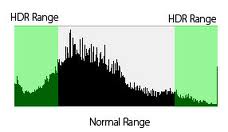Someday, Walmart will sell TVs capable of blinding you. But until then, we have to deal with weak displays that cannot reproduce the sun's luminosity. And High Dynamic Range images will have to be viewed by proxy.
Tones that fall in the HDR range of the histogram are tones that are impossible to display on your monitor and therefore appear as blown out or completely stopped up spots in an image.
In video games with an HDR graphics pipeline, the exposure is controlled automatically. http://www.youtube.com/watch?v=-spSQYtVfuk The game acts like a digital video camera, truncating the histogram based on what's in the center of the frame.
However, with static HDR photographs or panoramas on a computer screen, there is no such region-of-interest-based automatic exposure. The entire picture has to be tone mapped, flattening out the image's dynamic range. If you ask me, that defeats the purpose of retaining HDR images in the first place.
One way around this is to create an interactive HDR viewer that would tune the exposure for, say, the region near the mouse cursor. But an even better option would be to track the user's gaze. Now we're in academic territory.
Interactive viewing could be implemented in browser with these cool HDR Javascript tools: http://pfstools.sourceforge.net/hdrhtml.html. Actual gaze tracking in the browser, well, that I'm not so sure about.
Another cool site that demonstrates true HDR: http://www.hdrlabs.com/gallery/realhdr/

Leave a Reply